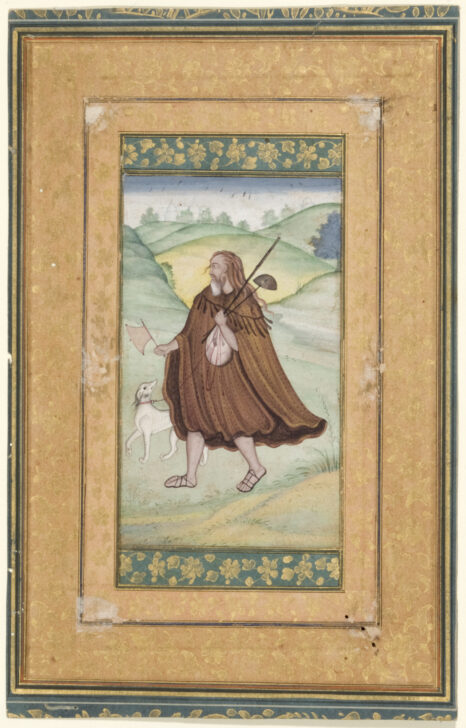A wandering Shaivite ascetic with his dog
Indian; Mughal

Description
Gallery Rotation Fall 2013
Mughal workshop
India, Uttar Pradesh
A wandering Shaivite ascetic with his dog
late 16th–early 17th century
Opaque watercolor and gold on paper
Museum purchase, Acquisition Fund, 1969/2.175
This depiction of a wandering devotee of Shiva combines the perfect profile view typical of Indian royal portraits with a more naturalistic approach to the figure inspired by European prints and drawings. The figure’s striding posture was likely copied from a European source that made its way to India via Jesuit missionaries in the late sixteenth century. Other aspects of this picture also imitate European techniques, such as the blue haze used to indicate the depth recession of a distant landscape.
As Muslim immigrants from Central Asia, Mughal rulers were fascinated by local Indian religious practices. Hindu holy men, in particular, were popular subjects for their court artists. Painters often applied newly acquired techniques to portraits of ascetics, yogis, and other esoteric figures—perhaps as a means of capturing their perceived strangeness. Here, the artist has focused great attention on the ascetic’s matted locks and fur cape.
Subject Matter:
A Hindu ascetic, walking with his dog in an idealized landscape, with city buildings visible on the horizon.
This work dates to a pivotal moment in the history of Mughal painting: the year when Jahangir replaced his father, Akbar, as emperor and chief patron of the imperial painting atelier. Both father and son were fascinated by Hindu ascetics, and frequently commissioned their artists to paint their portraits. In this unsigned work, an unnamed ascetic garbed in a flowing brown robe is seen striding purposefully through a landscape of gently rolling green hills, accompanied by his dog. Portraiture featuring a single figure shown in profile is a type that emerged under Akbar (r. 1565–1605), but it was under Jahangir (r. 1605–27) that it acquired greater psychological depth.
Every element of this naturalistic portrait demonstrates the skill and sensitivity of the Mughal artist, from the careful study of foreground plants to the dignity of the saint-like figure and the silhouettes of trees in the distance. The blue and green hues of the landscape are ultimately derived from Persian painting, but the treatment of light and shadow and the close observation of nature have been learned from European art, brought to the Mughal court by Jesuits, diplomats and traders.
Physical Description:
This work is a double-sided page from a bound album. The painting, depicting a Hindu ascetic walking with his dog in a pastoral landscape, has been placed in a border, decorated with a floral scroll painted in gold on a blue or pale orange ground; a similar border surrounds a calligraphy panel on the reverse side. The border and the calligraphy panel are both somewhat later in date than the painting itself.
The painting of the ascetic and his dog is pasted onto an album page. It is surrounded by a series of gold floral borders alternating blue and saffron-colored backgrounds. Wearing a brown poncho-like garment and carrying a fan in his right hand and a bag of his belongings, the lead attached to his white dog, and some tools in his left, he strides through the landscape. He wears sandals and has long brown matted locks of hair and a graying beard. The landscape consists of intersecting rounded forms in shades of green and yellow, surmounted by trees along the top and with a larger blue-foliaged tree to the right near the horizon. At the bottom a diagonal of yellowish rise of land with clumps of grass suggests some depth and a foreground, but the figure is quite flat in the middle ground.
On the back of the page is a Panel of calligraphy consisting of a quatrain in Shah Jahan's handwriting signed "Sultân Khurram [his given name before he took the name Shah Jahan upon becoming emperor" and dated 1020/1611-12. This is also surrounded by elaborate borders.
Usage Rights:
If you are interested in using an image for a publication, please visit https://umma.umich.edu/request-image/ for more information and to fill out the online Image Rights and Reproductions Request Form.